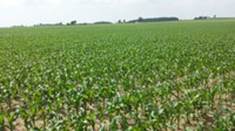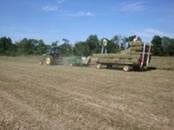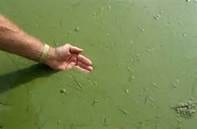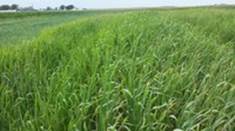Good afternoon,
This past week we had our OSU Extension Agriculture and Natural Resources Summer Retreat in southern Ohio at the Shawnee State Park. I had an opportunity to visit the Beef Research Facility in Jackson, learn about the management of the Shawnee State Forest, and find out about the fruit and vegetable research being conducted at OSU South Centers in Piketon. Most of all, it was a chance to get updated on OSU Extension business and network with other Extension Educators to ask questions and share information.
Back here in Hardin County the rain continued to fall as it did in southern Ohio. I received reports of the rain while down south and then began to add things up. Several of the rainfall reports we received from the township reporters for the month of May were around 4 inches. Add to that an average of 6.25 inches from the CoCoRaHS rainfall reporters, with one reporter registering 7.86 inches in the week Friday-Friday, and you get the pattern. Allen County seemed to get even more rainfall than us. Take a look at the attached rainfall report map for the week ending 6/21 and also the one for the month ending 6/21 and you will see where I am going with this.
What effect does this have on the crops? It doesn’t take too much of a drive around the county roads to see the impact of these most recent heavy rains. How will this affect the potential loss of nitrogen? What is causing the soybeans to turn yellow? And how much disease pressure will we see as a result of this weather? Read the attached news article from this past week for more information about the heavy rain’s effect on corn and soybeans. Hopefully the soil will soon drain from these recent events and roots will take off. Once the roots continue to grow and are able to access the nutrients, there should be an improvement with the corn. Also, warm weather and drier soil conditions will encourage nodule growth on soybeans, causing the beans to green up if they haven’t already been drowned out from water sitting too long in field. I have also included a timely article from Ed Lentz which helps explain the challenges of this year’s crop season so far and what one should be on the lookout for as they scout the crops.
Heavy Rains Affect Corn-Soybeans
Crop Growing Season Challenges
Upcoming events this week include ‘An Evening Garden Affair’ with former NBC4 garden expert Tom Wood at Harco Industries tonight (6/22), starting at 6:00 pm. Livestock Quality Assurance Training for Jr. Fair Livestock Exhibitors will be Wednesday, June 24 starting at 6:30 pm in the Community Building at the fairgrounds. The Farm Bureau Annual Meeting and Summer Party will also be in the Community Building at the fairgrounds on Thursday, June 25 starting at 7:00 pm. Coming up on June 29 is Family and Consumer Sciences Extension Educator Kathy Oliver’s Retirement Celebration. See the attached flyer about this memorable event and come wish Kathy the best as she begins this new phase of her life. Previously, I mentioned it was going to be held at the Extension office, but now the location is the Abundant Life Assembly of God church. Below are some agronomy articles that you may be interested in reading.
Mark
What’s the Right N Rate for Corn in Ohio? – Harold Watters
The first answer is we don’t know. The truth is that our soils, rainfall, temperatures, the year-to-year variation and cropping systems are different enough that any rate we tell you will be wrong. We formerly used crop yield goal to determine our nitrogen (N) rate. With a corn yield of 160 bu/A we would recommend 190 pounds of N per acre in a corn after corn situation, and 160 pounds after soybeans. We gave a credit of 30 pounds nitrogen for soybeans. Those assumptions of the need for about 1 pound of N/bushel of corn and 30 pounds of N credit after soybean were wrong. To read the full article, go to http://corn.osu.edu/newsletters/2015/2015-16/what2019s-the-right-n-rate-for-corn-in-ohio.
OSU Weed Science Field Day – Mark Loux
The 2015 OSU Weed Science Field Day will be held on Wednesday July 8 at the OARDC Western Ag Research Station. Registration starts at 8:30 and a field tour with presentations by OSU faculty, staff and students will start at 9 am. There is also, as usual, the opportunity to view studies of interest on your own. The cost is $30, which includes the tour book and lunch. Please RSVP to Bruce Ackley, Ackley.19@osu.edu, and include the number of people in your group. Payment can be via cash or check the day of the event. Address of the research station – 7721 South Charleston Pike, South Charleston, OH. Location – about 5 miles south of I-70 on SR 41.
Look Out for Potato Leafhoppers in Alfalfa – Andy Michel
Now that most alfalfa has had its first cutting, it is time to begin sampling for potato leafhoppers as the crop reaches a sufficient height for sweep-net sampling. A single sample is 10 sweeps of a sweep net. When the average number of adults and nymphs in a sample is equal to or greater than the average height of the alfalfa stand, insecticide treatment is warranted. For example, if the alfalfa is 6 inches tall and the average number of leafhoppers is 6 or higher, you should consider an insecticide application. If the average is lower, then re-sample the field in a few days. Go to http://corn.osu.edu/newsletters/2015/2015-16/look-out-for-potato-leafhoppers-in-alfalfa to finish reading this article.
NOAA Lake Erie Algal Bloom Projection – NOAA
The National Oceanic and Atmospheric Administration has combined data from the National Center of Coastal Ocean Science and Heidelberg University’s National Center for Water Quality Research to predict the severity of harmful algal blooms in western Lake Erie. The first projection is as follows: The severity of the western Lake Erie cyanobacterial harmful algal bloom (HAB) is dependent on phosphorus inputs from March 1st through July 31st, called the loading season. This new experimental product projects the bloom severity based on the combination of measurements of discharge and phosphorus loading from the Maumee River for the loading season to date with historical records from past years to estimate the remainder of the loading season. For more information, go to http://corn.osu.edu/newsletters/2015/2015-14/noaa-lake-erie-algal-bloom-projection.
Supplemental Forage Options for Early Summer Planting – Mark Sulc
Now that first harvest of forage crops is completed or in progress, some may be noticing the low yields in damaged forage stands, or they may realize the need for additional forage supplies this summer. There is always the temptation to no-till something into existing stands in an effort to produce more tonnage, but I believe that is a risky proposition this time of the year. The existing stand will compete heavily for moisture and regrowth of the existing stand will shade new seedlings struggling to get established. So at this point in the year, I think it is best to either kill a poor stand and seed an annual crop for summer forage production, or find open land available to seed an annual forage for supplemental feed. To continue reading about forages, go to http://corn.osu.edu/newsletters/2015/2015-16/supplemental-forage-options-for-early-summer-planting.
Mark A. Badertscher
Agriculture and Natural Resources Educator
OSU Extension Hardin County
1021 W. Lima Street, Suite 103, Kenton, OH 43326
419-674-2297 Office





